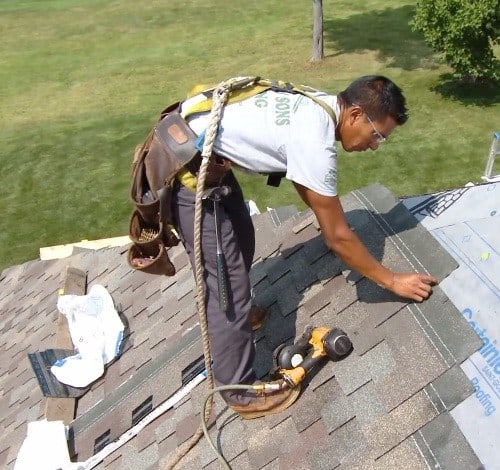Wind Resistant Roofing Shingles–Protection From The Elements is Important
3/18/2015
 While an important factor in choosing roofing shingles is the color and design, it’s also important to assess wind-resistant roofing shingles, especially living in areas with high winds.
While an important factor in choosing roofing shingles is the color and design, it’s also important to assess wind-resistant roofing shingles, especially living in areas with high winds.
How well shingles will protect our home from the elements is a very important factor for your roofing selection. High winds can loosen shingles and cause them to lift from and/or blow off of a roof, and this can compromise your roof system by allowing moisture to infiltrate into the building materials below the protective layer of shingles.
So, what measures are taken to resist high wind and keep the shingles on the roof? Let’s begin by ‘looking’ at a shingle.
What makes shingles great wind-resistant roofing materials?
If you were to hold a conventional roofing shingle in your hand you would notice one or more lines marked across the front of a shingle. These markings indicate the nailing strip, which is the area designated for nailing by the manufacturer.
Pull-through resistance – Just as significant as proper nailing is the strength of the shingle – particularly a factor known as pull-through resistance. Pull-through resistance is a measurement of the force required to pull a shingle over the head of a roofing nail holding it in place. This is why the quality of the components that make up a shingle are so vital, and why manufacturers mention the industry standards their products meet and the independent laboratory tests that their products go through in order to verify the durability of their shingles.
Self-sealing adhesive – Further inspection of a shingle would reveal a self-sealing adhesive asphalt strip, either on the face or the back of the shingle, which is applied during the manufacturing process. Whereas roofing nails secure the shingles to the roof substructure (typically, sheets of plywood called ‘the roof deck’), this adhesive strip secures the shingles together.
Overlapping created wind-resistant roof design – Shingles are installed in overlapping layers, and the adhesive strip is placed on the area of the shingle which comes into contact with other shingles. Once the shingles are installed, the adhesive strips become thermally activated by the warmth of the sun and create a cohesive bonding of each shingle in a roof system.
The wind resistance of roofing materials and wind-resistant roofing material design comes from the combination of the above factors and measures that create the levels of redundancy designed to keep your shingles fixed to your roof. This is why the proper installation of a high-quality wind-resistant roofing materials by a professional roofer is recommended for anyone thinking about a new or replacement roof.
Want to learn more about the proper installation of a wind-resistant roof? Contact the Littleton roofing experts at CJ Roofing >

 While an important factor in choosing roofing shingles is the color and design, it’s also important to assess wind-resistant roofing shingles, especially living in areas with high winds.
While an important factor in choosing roofing shingles is the color and design, it’s also important to assess wind-resistant roofing shingles, especially living in areas with high winds.